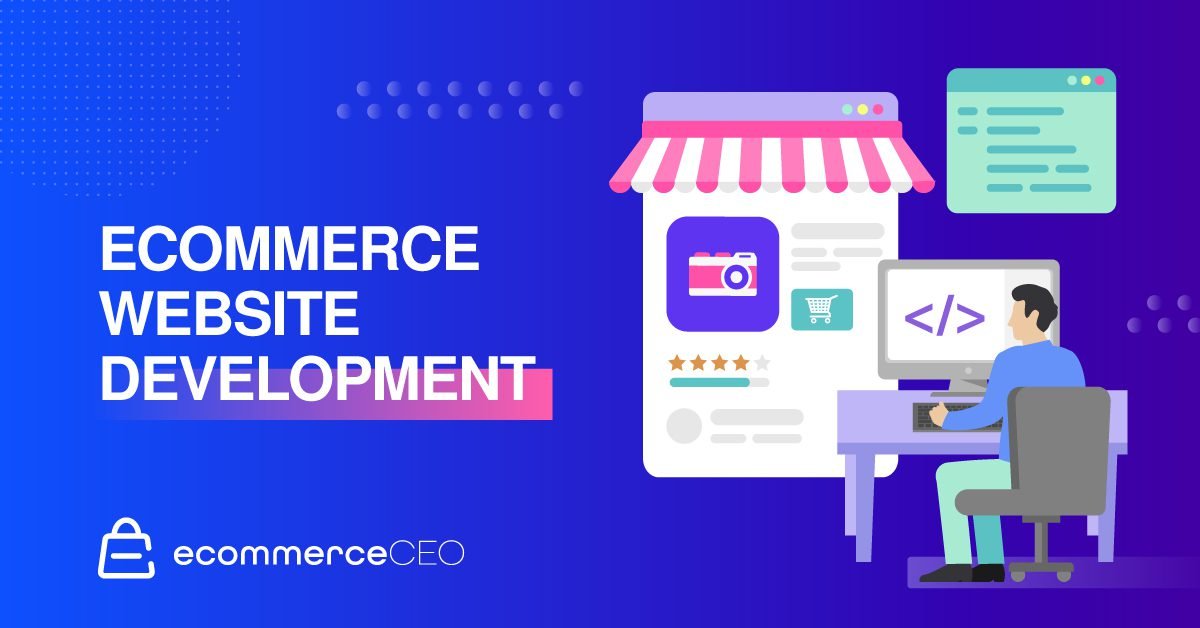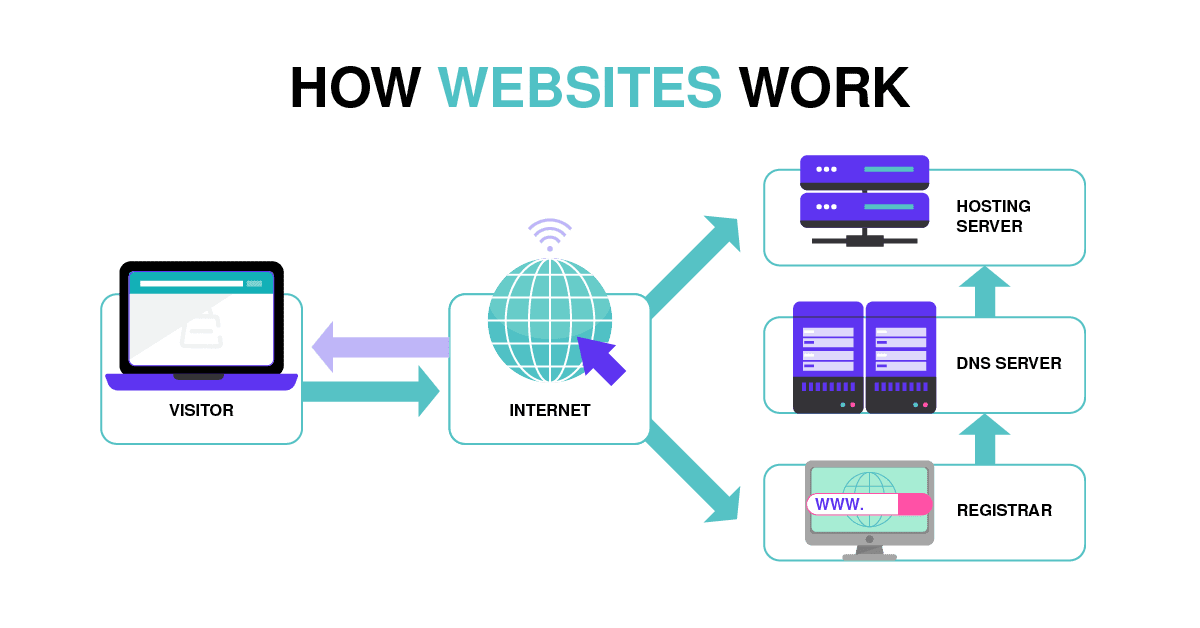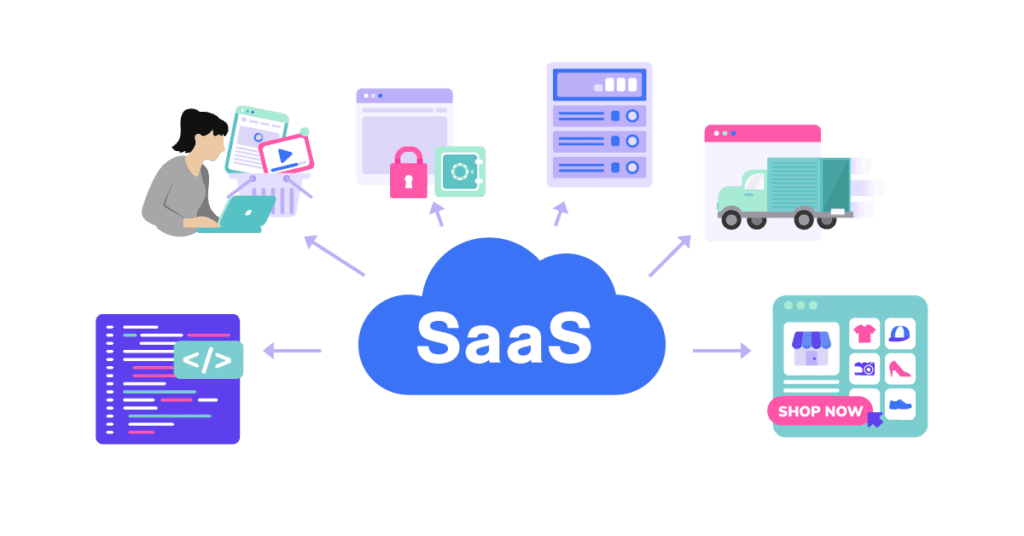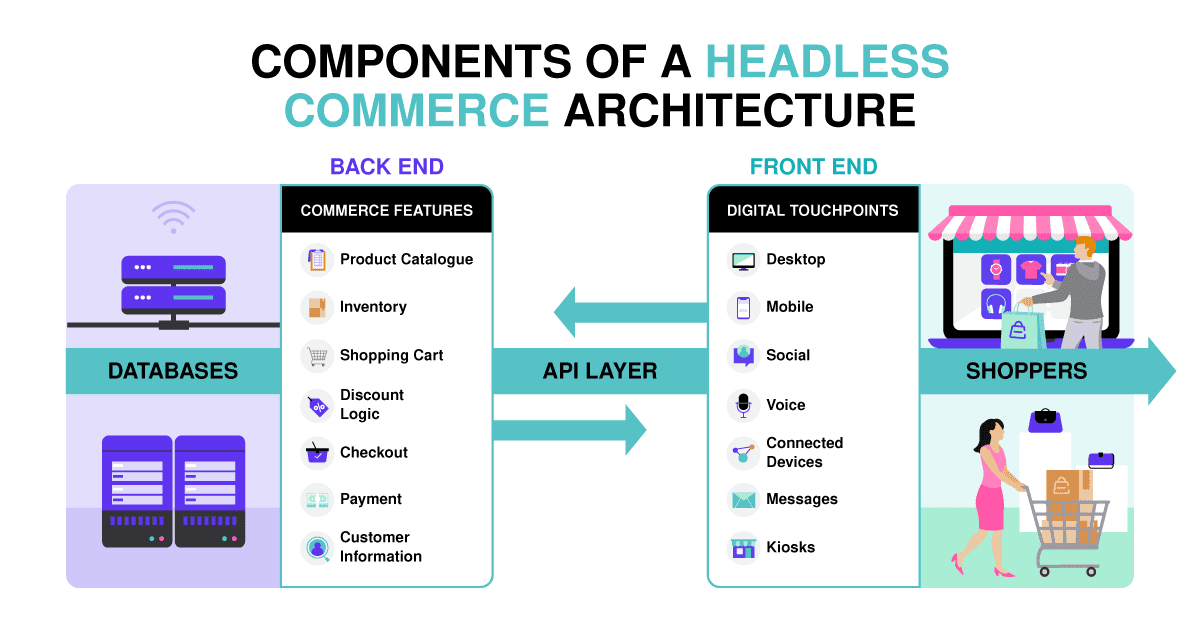In today’s world, it is hard to find a company that does not have an online presence. When starting an ecommerce website of your own, it’s crucial to know that design and development aren’t the same things.
You need both ecommerce website design and development for a functional website. You can still build an effective website without hiring a developer if you’re not a highly technical person. Hiring a professional comes down to what you need from your website.

The U.S. web development services industry is currently valued at $11 billion and opens the door for businesses to create user-friendly websites for their target market.
We’ll walk you through ecommerce web development, your options, how to choose the right developer, factors you need to consider, and more so that you can make the best business decision when starting your ecommerce business.
What is Ecommerce Website Development?
Ecommerce website development is a process that begins with designing a functional and appealing website. After the initial design is complete, ecommerce developers create the necessary backend code to enable the website to function properly and allow customers to purchase products. The final step in this process is ensuring that all of the features and functions of the website are up and running smoothly.
Research from Nasdaq shows that by 2040, an estimated 95% of purchases will occur through ecommerce.
Options for Developing Your Online Store
You have three options for building your ecommerce store:
- Building from scratch with a development team
- Customizing an existing software as a service (SaaS) solution
- Taking advantage of MACH architecture
Build from Scratch

Using an open-source ecommerce platform may be the best option if your company already has an IT team.
With an open-source option, you can modify everything about the code so that you can build your website with limitless customization options.
It does mean that your business will be responsible for website hosting, security issues, and PCI compliance. You’ll have to keep the site’s code up to date and have measures in place to prevent hackers from accessing consumer information.

Because of this, some companies feel that open source solutions are too technical, expensive, and awkward as the business evolves and becomes more complex.
Customize a SaaS Solution

With ecommerce solutions like BigCommerce and Shopify and similar alternatives, you have a SaaS solution you can customize to meet your needs. You pay monthly to cover your hosting and access to the software, which handles all the security and PCI compliance for you.
They are a great way to get to market quickly and affordably if time and budget are a concern. And with BigCommerce, you have access to an open API which gives you the freedom and flexibility of an open source platform without the hassle of managing the technical aspects.
Use the MACH Architecture
The traditional ecommerce model has required the front-end (your storefront) to be tied directly to the backend (the behind-the-scenes transaction processing) in a single setup. Though this approach could still be the best option for many small and medium-sized businesses, it can be challenging for larger and enterprise-level companies. Its limitations present challenges if you need to launch multiple websites or expand your service area to new regions. That’s where MACH principles come in, so you can customize the ecommerce web development solution that works best for your business.
Microservices
As the name suggests, microservices are small services designed to take care of a particular task, brought together to create an application. Each microservice is developed, updated, deployed, and managed independently with different code.
API-First
APIs, which stand for application programming interfaces, are what connect two or more applications/services to facilitate communication between them.
Cloud-Native
Cloud-native applications leverage the cloud and SaaS to take care of the technology behind it and provide it to consumers on a subscription basis.
Headless

Headless commerce decouples the front-end presentation of a website from the backend commerce features. It gives businesses more flexibility when building the user interface and necessary integrations for an online store.
Choosing the Right Ecommerce Website Developer for You
Research from PWC shows that nearly 3/4 of consumers say customer experience is an important factor in their purchasing decisions. Still, roughly half of consumers say brands do well with that experience.
To ensure your ecommerce business provides a stellar customer experience on your site, hire a developer with plenty of experience designing and developing ecommerce websites.
Most of today’s SaaS solutions and some of the open-source solutions, like WordPress, have extensive directories of developer partners who are experts in the system, along with best practices. If you’re working with a Shopify ecommerce site, look at our list of the best Shopify developers.
Consider Your Needs
Don’t hire an ecommerce development company until you fully understand what you want and need from your own website. Only then will you know what skills you require of a developer.
Let’s say you’ve chosen an open-source ecommerce solution for your website. In that case, a backend developer is more likely to be critical than a front-end developer – but you may still need both.
On the other hand, if you’ve chosen a SaaS solution, you’ll likely need more front-end work than the backend since the SaaS ecommerce platform handles a lot of the backend stuff for you. You may need to find a developer comfortable working with APIs, though. SaaS platforms have a variety of pre-built integrations, but if you require something more complex than what’s available, you’ll need to hire an expert to help you.
Evaluate Developers’ Strengths
All ecommerce web developers have strengths and weaknesses. Some are better at handling the front-end design, while others are better at handling the technical implementation. Some developers can handle both the front-end and the backend but naturally will tend to favor one over the other.
For the greatest chance of success, choose website development services with skills aligned to your ecommerce business needs.
Factors to Consider During Ecommerce Web Development
What you need from your website will vary based on your business model. Consider your goals and build a list of the features you must have.
For instance, as a startup, you may not need support for currency conversion, but an international company will.
Start with the general essentials, such as your required marketplace integrations and payment gateways.
Then, add extras such as automatic shipping and tax calculation.
On a scale from one to five, with one being crucial and five being a nice-to-have for efficient operations, prioritize everything.
Design Responsiveness
According to Statista, mobile commerce sales will account for more than 10% of all U.S. retail sales by 2025.
As more people use mobile devices to shop, you need to be sure your website supports a mobile-friendly ecommerce web design. Alternatively, you could have a web developer build a mobile app. With responsive design, your website automatically adjusts to the viewer’s device’s screen size for usability. Additionally, the navigation and layout should be optimized for online shopping.
Whether you opt for a mobile responsive design or a separate web app, the goal is to deliver a consistent, high-quality shopping experience no matter which device (desktop, phone, tablet, etc.) a customer chooses to access your website.
Site Speed
According to Google, the probability of a website visitor bouncing increases dramatically the longer your website takes to load. As your page load time increases from 1 to 3 seconds, the likelihood of them bouncing increases by 32%. As a page load time increases from 15 seconds, the probability of a bounce increases by 90%.
That means you need a developer skilled in optimizing your site for speed or an ecommerce platform optimized for speed.
Site speed also plays a role in search engine optimization, or SEO, as Google prefers sites with a quality user experience.
Search Engine Optimization (SEO)
SEO is one of the most effective ways to drive organic traffic to your website. It involves optimizing your site to appear higher in search results when people type keywords into Google or Bing. This way, more potential customers see your site when they search for what you offer.
Many SaaS solutions factor SEO into their platform, giving you tools to make content optimization easier.
If you’re building from scratch, you must consider SEO features and functionality, as code errors and bloat can slow down your site and negatively affect rankings.
Content Management System (CMS)
A CMS is a vital part of the ecommerce web development puzzle since you’ll need a way to manage your content. You need a robust CMS with various features to help manage your content. These include:
- Tools for creating new pages
- Editing existing ones
- Managing images, videos, and more
Many ecommerce platforms have built-in CMS tools that also allow you to create custom fields for product data, making it easier to track inventory and keep tabs on sales.
Product Management
Your ecommerce website needs the ability to add, edit, and track inventory. This way, you can monitor sales to ensure your most popular products are always in stock, prevent overselling, and stop wasting money on inventory that doesn’t sell well.
Payments and Checkout
Today’s consumers use digital wallets like Apple Pay and Google Pay and payment services like PayPal and Venmo to make purchases online. If you don’t make these options available, you risk losing sales. There are various online payment gateways you can for the checkout process.
Giving customers the freedom and flexibility to choose the payment method that is most convenient for them is a critical part of boosting your conversion rate.
Website Security
As an ecommerce business owner, you’ll have to deal with a ton of sensitive information, such as:
- Customer addresses
- Phone numbers
- Credit card numbers
- Bank account numbers, and other payment data
You’re legally responsible for handling it carefully, meaning you must be PCI compliant. Failure to do so may mean fines, loss of consumer confidence, and no longer being able to accept payments.
If you don’t use a platform that handles PCI compliance for your online store for you, you’ll need a developer to help you figure it out.
Integrations
You may find that your ecommerce platform lacks the features you want, so you’ll need to use integrations to customize the site to your needs. Do you use an ERP, CRM, OMS, or PIM with your business? You’ll need a system that ingrates with the tools you’re already using, or you’ll have to hire a developer to build the 3rd party integrations for you. Will the platform integrate with your email marketing platform and support your overall marketing strategy?
Digital Marketing Strategies
Don’t wait until the end of the ecommerce development process to think about how you’ll market your business. Thinking about your strategy in the early stages helps to ensure you have the right site structure and any additional features you didn’t initially consider.
For instance, if your marketing strategy includes social media, adding social sharing features to your website may make sense. If you’re planning to rely on mobile commerce, you’ll want to build a mobile app for your online business or, at the very least, add push notifications.
Best Practices for Ecommerce Web Development
Keep it Simple
Do everything with your customer in mind. Make everything about the site as simple as possible – on the front and back end. Include product filtering and search functions so shoppers can easily find what they want. Always offer detailed product descriptions to improve the customer experience.
If you’re unsure how to structure your site, consider hiring a focus group or conducting some usability testing to determine what your audience expects from a site like yours.
Prioritize Efficiency
As your business grows, your operations will become more complex. Bells and whistles are nice, but when determining the features you need, aim to make things simple for the customers while keeping things easy for your staff. Integrate your supplier inventory with your shipping software to make order fulfillment easier. If you’re working with a 3PL or fulfillment company, integrate it with your platform, so order fulfillment is automated.
Run Quality Assurance Test Before Launch
Even if you think everything will work as it should, test it again.
- Double-check all your calls to action and ensure forms on landing pages work.
- Go through the checkout experience to ensure it is as seamless as possible.
- Check over your payment processing integrations to ensure they all work as intended.
- Ensure images are optimized for quality and load speed.
- Audit your product categories and listings to ensure you have everything categorized and product descriptions in place
- Make sure all links work correctly.
- Check that inventory numbers line up correctly and are listed correctly.
- Verify tax and shipping settings are correct
- Test coupon codes, promos, and discounts.
- Test the site across desktops and mobile devices to ensure a quality experience across the board.
FAQs
Time to Start Developing Your Ecommerce Website
The more complex your website project is, the more likely you’ll need to partner with a website developer. Take a look at our 56-point ecommerce website checklist to ensure you’ve gotten everything you need before you launch.









